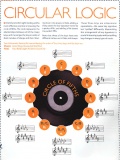Circle of Fifths A Circle of Fifths chart is a
visual representation of the major and minor key signatures arranged in order
of ascending and descending perfect fifths. On the circle, the addition or
subtraction of a sharp or flat to any key signature creates a new key that is
either up a perfect fifth (in the case of addition of a sharp or flat), or down
a perfect fifth (in the case of subtraction of a sharp or flat) from the
original key. For example, the key of D Major has two sharps (an F and a C).
Logically, the Circle of Fifths diagram is
circular in shape, much like an analog clock. When a sharp is added, the new
key is placed clockwise on the diagram. When a sharp is removed or a flat is
added, the new key is placed in a counterclockwise position relative to the
previous key. Major and minor keys with the same number of sharps and flats are
placed together.
The Circle of Fifths Diagram has many uses. The most
obvious is to allow one to determine the key of the music he or she is playing.
If a piece has two sharps, a quick glance at the circle tells the student that
the music may be in one of two possible keys: either D major, or b minor. If,
instead, the music has four flats, the possibilities are either A-flat Major or
f minor.
Another use of the circle is to help the student
memorize scales. When learning scales, the student can use the circle to
determine how many sharps and flats there are in any given key, and thus which
notes must be "raised" or "lowered." One can also determine from the diagram how
the keys are related.
A third use of the Circle of Fifths diagram is to
determine the relative major of any minor key (the minor scale with the same
key signature as the major scale) since these are placed together on the circle.
Similarly, the dominant chord of any key is one clockwise step away from the
tonic, and the subdominant (or IV chord), is one step counterclockwise removed
from the tonic. Seeing these chords represented on a diagram can help the
student understand basic harmony.
These concepts, which are rather difficult to
describe in writing, are easy to understand on the Circle. I encourage every student to use the Circle
of Fifths chart to help with understanding of key signatures and scales.
Click on this picture to see the Circle of Fifths in full view: 
|